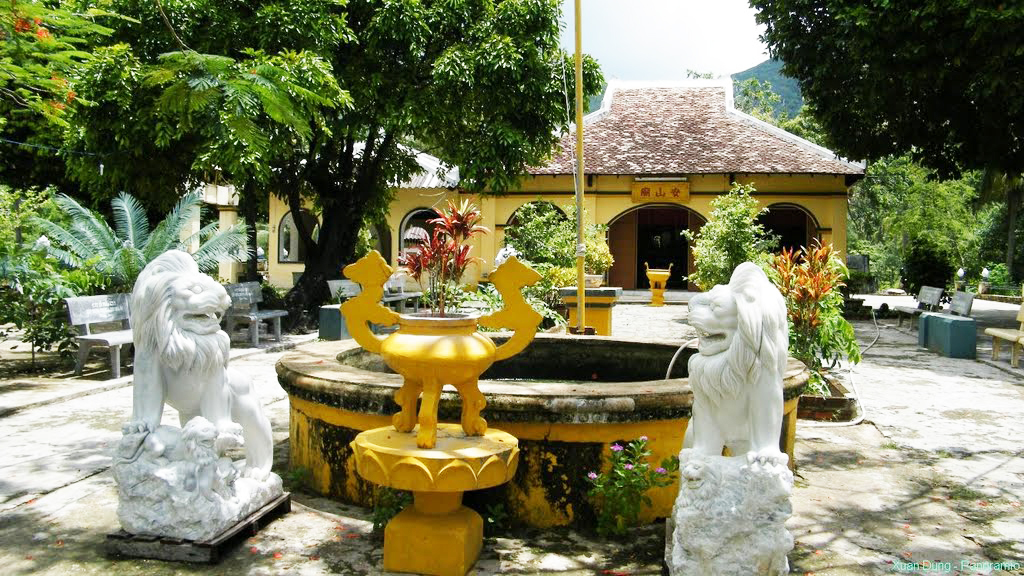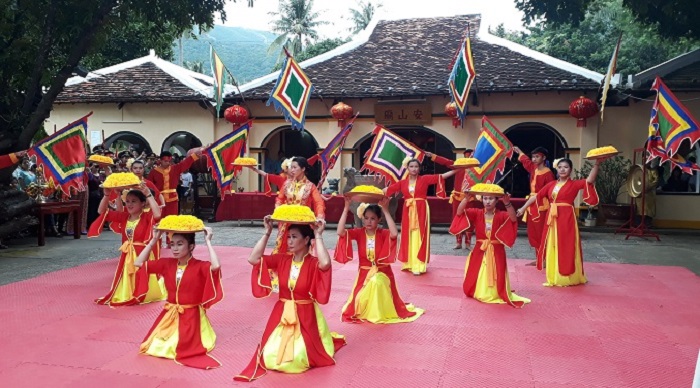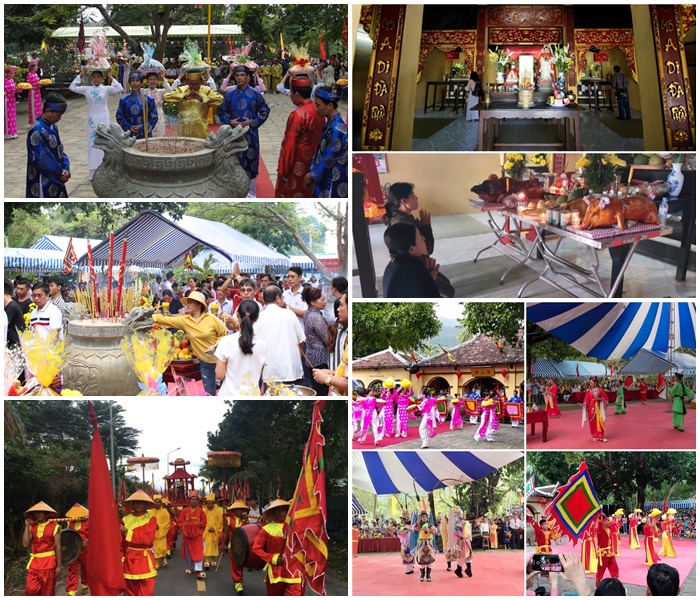Why is Phi Yen’s death anniversary registered as a national cultural heritage?
Phi Yen’s character is only in the legend?
In the past few days, the story of the Nguyen Phuoc Tribe Board of Directors (descendants of King Gia Long) and a number of cultural and historical researchers signed a petition to revoke the decision to recognize the national intangible cultural heritage. for “The death anniversary of Madame Thu consort Hoang Phi Yen in Con Dao district, Ba Ria – Vung Tau” has received the attention of many people.
Before making this application, the descendants of King Gia Long and scientists held a scientific discussion to clarify that Phi Yen – who is worshiped at An Son temple, Con Dao is not the wife of King Gia. Long and there is no story that King Gia Long threw his son into the sea during his escape from the Tay Son army as many legends are “floating” in folklore.

An Son Temple worships Phi Yen in Con Dao. Photo: TL.
So, why is the character of Mrs. Phi Yen not in history, ie just a character of legend, but her death anniversary is listed as a national intangible cultural heritage?
According to documents provided by the Department of Cultural Heritage (Ministry of Culture, Sports and Tourism) Vietnamese people On October 27, 2021, the Department of Cultural Heritage received a report from the People’s Committee of Ba Ria – Vung Tau province on the proposal to recognize the death anniversary of the second wife Hoang Phi Yen in Con Dao district, Ba Ria – Vung Tau province. on the list of the National Intangible Cultural Heritage.
After studying, it was found that the content and composition of the Dossier met the provisions of Circular 04/2010 of the Ministry of Culture, Sports and Tourism, stipulating the inventory of intangible cultural heritage and making scientific records of cultural heritage. Intangible cultural heritage for inclusion in the National Intangible Cultural Heritage List, on January 21, 2022, the Department of Cultural Heritage organized to consult the Intangible Cultural Heritage Appraisal Council as a basis for the assessment of intangible cultural heritage. Department proposes the Minister to include in the List of National Intangible Cultural Heritage in accordance with the appraisal process.
In the Provincial Relic Ranking Profile An Son Temple (An Son Temple, the place where the death anniversary of the second wife Hoang Phi Yen took place) of Ba Ria – Vung Tau Province (Decision No. 1442/QD.UB dated April 18// 2007) and Scientific Records of Intangible Cultural Heritage The death anniversary of the second concubine Hoang Phi Yen shows that Hoang Phi Yen (also known as Le Thi Ram) is the concubine of Lord Nguyen Phuc Anh (ie King Gia Long). ) is a legendary character.

Phi Yen’s death anniversary has many religious practice activities. Photo: TL.
According to the legend of the inhabitants of the island, during her lifetime, she and the Nguyen Lord fled the Tay Son army and fled to Con Dao. Here, her mother and daughter met with injustice, the child was thrown into the sea to die, once nearly humiliated, she chose to commit suicide to keep her integrity. Admiring her virtue and frugality, seeing that her mother and daughter died, the islanders built a temple (about 1785) to worship since then. As usual, every year, they often hold her death anniversary at An Son Temple.
Phi Yen’s death anniversary meets the criteria for intangible cultural heritage
According to the Department of Cultural Heritage, Ms. Hoang Phi Yen is a character who, although only recognized through legends, has been worshiped by the resident community in Con Dao since time immemorial and considers this to be the core of belief (the sacred) of the festival at An Son Temple, whose date is determined to be the death anniversary of the second wife Hoang Phi Yen.

Vivid images of cultural activities in the annual anniversary of Mrs. Phi Yen. Photo: TL.
“It is a cultural expression/cultural practice that meets the criteria under the UNESCO definition of intangible cultural heritage (Convention 2003 for the Protection of Intangible Cultural Heritage) and at Law on Cultural Heritageto be identified as an intangible cultural heritage.
The inclusion of this heritage in the list of National Intangible Cultural Heritage is a recognition of the religious activities of the island community, recognized and protected by law, and also a recognition of the the value, role and meaning of the festival to the resident community, as well as the community’s role in creating, maintaining and transmitting their cultural identity to create the cultural diversity of the community. Vietnam’s ethnic groups, but does not mean to register characters in legends or to register historical stories or related legends”, the document of the Cultural Heritage Department clearly states.
According to the Department of Cultural Heritage, in fact, in terms of intangible cultural heritage associated with legendary characters, similar to the case of the legendary character of the concubine Hoang Phi Yen, in our country, many beliefs, Traditional festivals of some other communities associated with legendary characters have been included in the Representative List of Intangible Cultural Heritage of Humanity by UNESCO or decided by the Minister of Culture, Sports and Tourism to be included in the List of Cultural Heritage. nationalization.
Among these can be mentioned: Practicing the Vietnamese beliefs of worshiping Mother Goddesses of the Three Palaces (in the area of 21 provinces, associated with the Tam – Tu Phu god system) was registered by UNESCO in 2016; Belief in worshiping Hung Vuong (Phu Tho, associated with the legend of the Hung Kings), listed by UNESCO in 2012; Giong Festival at Phu Dong Temple and Soc Temple (Hanoi, associated with the legend of Saint Giong) was registered by UNESCO in 2010; Shoe Covering Festival (Nam Dinh, associated with the legend of Lady Chua Lieu Hanh) was included in the National Intangible Cultural Heritage List in 2013. Chem communal house festival (Hanoi, associated with the legend of the giant Ly Ong Trong) was included in the list of National Intangible Cultural Heritage in 2016.
On a national scale, there are currently 65,900 intangible cultural heritages inventory, of which only 431 are included in the list of national intangible cultural heritage by the Minister of Culture, Sports and Tourism, with 171. heritage in the form of traditional festivals.
Most of these festivals have “sacred” elements, associated with myths and legends related to the characters being worshiped, such as saints, historicized gods (folk deities/saints). creations are enriched with historical elements – such as Saint Giong) or real historical figures are mythized (real people are fortified with mythical elements, “sanctified” like Tran Hung Dao) to have a firm foothold in the flow of folklore and in the community’s consciousness. It is one of the elements constituting the intangible cultural heritage.
“Compared with tangible cultural heritage, intangible cultural heritage is difficult to identify and access. While the concept as well as activities to protect and promote the value of this type of heritage is relatively new. (officially legislated in 2001); the inventory and making of scientific records to put the heritage on the list of intangible cultural heritage is just one of the initial stages of protection and promotion activities. intangible cultural heritage value.
Accordingly, the general perception of intangible cultural heritage among management, research, media and society is not really unified and even… Therefore, in the coming time, the Department of Heritage Culture will strengthen coordination with relevant localities, agencies and units, especially media agencies to provide information, propaganda and training to raise social awareness about cultural heritage in general. In general, intangible cultural heritage in particular, avoid interpretations and interpretations that are not in the spirit of the
Convention 2003, Law on Cultural Heritage on intangible cultural heritage and the inclusion of intangible cultural heritage in lists”, a representative of the Department of Cultural Heritage discussed further with Vietnamese people.
at Blogtuan.info – Source: danviet.vn – Read the original article here


